Across the borders of many countries, several possible friends and millions of neighbors live their lives in complete anonymity—until we meet them, that is. This week’s books contain stories of humor, hope and happiness from across national borders. There are humorous books from Mexico, serious books from Canada, and nail-biting escapes from a border in Germany where a wall that separated a nation finally fell. This week’s book reviews from the Children's Literature and Reading Special Interest Group (CL/R SIG) invite readers to learn about the journeys of our nearest neighbors and others who broke the walls and boundaries that confined them.
Grades K-3
Finch, Mary. (2013). La Gallinita Roja. Illus. by Kate Slater. Cambridge, MA: Barefoot Books.
 Many readers are familiar with, The Little Red Hen, and this book provides an alternative for those who love the classic. La Gallinita Roja tells the same story in Spanish. Since all of the text is in Spanish, the book provides a good resource for beginning Spanish Language Learners. The illustrations are made of paper crafts and collage, which add another dimension to the reading experience. At the end of the book, there is a recipe included to teach readers how to make their own bread—in Spanish.
Many readers are familiar with, The Little Red Hen, and this book provides an alternative for those who love the classic. La Gallinita Roja tells the same story in Spanish. Since all of the text is in Spanish, the book provides a good resource for beginning Spanish Language Learners. The illustrations are made of paper crafts and collage, which add another dimension to the reading experience. At the end of the book, there is a recipe included to teach readers how to make their own bread—in Spanish.
—Ying-Husan Lee, Washington State University Pullman
Cottin, Menena. (2013). Doble Doble. Col. San Miguel Chapultepec, Mexico: Ediciones Tecolote.
 This clever book introduces Spanish vocabulary for earliest readers and language learners. The colored pages of the book have two words in every spread. Bold illustrations present 30 vocabulary words in black and white. The words are presented on either the edge of a page, encouraging the readers to flip over the book and examine the illustration and words closely. Advanced vocabulary includes words such as Otoño, derecha, and hundir are clearly illustrated. This book is a great addition for any classroom or school library.
This clever book introduces Spanish vocabulary for earliest readers and language learners. The colored pages of the book have two words in every spread. Bold illustrations present 30 vocabulary words in black and white. The words are presented on either the edge of a page, encouraging the readers to flip over the book and examine the illustration and words closely. Advanced vocabulary includes words such as Otoño, derecha, and hundir are clearly illustrated. This book is a great addition for any classroom or school library.
—Rani Iyer, Washington State University Pullman
Weill, Cynthia. (2013). Mi Familia Calaca: My Skeleton Family. El Paso, TX: Cinco Puntos Press.
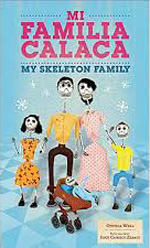 Come and meet a special big family with grandparents, parents, two children, and a baby. What is so special about this family is that everyone is a skeleton—even the family pets. As pages are turned, readers are able to see bilingual texts, English and Spanish, to present simple ways to introduce family members as well as paper mache illustrations, an important art form in Mexico. Moreover, instead of being scary, the skeleton is a lovely and humorous figure in Mexican culture. This is an entertaining book for children to learn both English and Spanish while also learning about an important part of one culture.
Come and meet a special big family with grandparents, parents, two children, and a baby. What is so special about this family is that everyone is a skeleton—even the family pets. As pages are turned, readers are able to see bilingual texts, English and Spanish, to present simple ways to introduce family members as well as paper mache illustrations, an important art form in Mexico. Moreover, instead of being scary, the skeleton is a lovely and humorous figure in Mexican culture. This is an entertaining book for children to learn both English and Spanish while also learning about an important part of one culture.
—Ying-Hsuan Lee, Washington State University Pullman
Wheeler, Lisa. (2013). Dino-Wrestling. Illus. by Barry Gott. Minneapolis, MN: Carolrhoda Books.
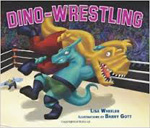 Dinosaurs line up in front of a massive tent, and everyone looks extremely exciting. Yes, it is about time for the Dino-Wrestling Jamboree. All dinosaur athletes can choose to compete in different wrestling styles, including Folkstyle, Luche Libre, Greco-Roman style, Sumo, and Free-Style. Are you ready for the wrestling matches? This is an informative book with cultural elements sprinkled throughout the text. By introducing different styles of wrestling with eye-catching dinosaur characters, the author also presents specific cultures aligned with wrestling styles. For example, Luche Libre is a Mexican style of wrestling with competitors wearing bright-colored masks and tights during the match, while Sumo is a Japanese style of wrestling derived from the Shinto religion. This informative text is presented with vibrant illustrations of wrestling dinosaurs, which will attract many young readers.
Dinosaurs line up in front of a massive tent, and everyone looks extremely exciting. Yes, it is about time for the Dino-Wrestling Jamboree. All dinosaur athletes can choose to compete in different wrestling styles, including Folkstyle, Luche Libre, Greco-Roman style, Sumo, and Free-Style. Are you ready for the wrestling matches? This is an informative book with cultural elements sprinkled throughout the text. By introducing different styles of wrestling with eye-catching dinosaur characters, the author also presents specific cultures aligned with wrestling styles. For example, Luche Libre is a Mexican style of wrestling with competitors wearing bright-colored masks and tights during the match, while Sumo is a Japanese style of wrestling derived from the Shinto religion. This informative text is presented with vibrant illustrations of wrestling dinosaurs, which will attract many young readers.
—Ying-Hsuan Lee, Washington State University Pullman
Grades 4-6
McIssac, M. J. (2014). Underhand. Victoria, Canada: Orca Books.
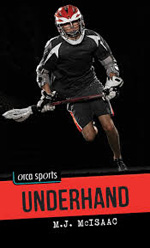 Markus is the star of the household. Nick, his younger brother, is just tired of being second best. It is sibling rivalry at its bitterest. When Markus wins a scholarship for a prestigious private school to play lacrosse, Nick can take it no more. He does his best to ruin the game for Markus, but being excellent at the sport, Markus has no trouble tackling his brother’s moodiness. Lindy, the dynamic young lady Nick wishes to date, has eyes only for Markus. Nick’s only solace is his best friend Kevin who supports his attempts to work out the sibling rivalry. Everything seems to be against Nick until Markus loses his offer due to allegations of cheating. When Nick and his friends receive a call from the recruitment coach of the private school, Nick cannot believe his luck. But he is also deeply affected by his brother’s moodiness and loss of morale. Nick is determined to use this opportunity to find out who made the allegations of cheating and why the coach was listening to him. Nick’s determination to find the culprit helps him find allies in unexpected places. Could sibling rivalry be more important than opportunity and honesty? Nick has to make some tough decisions and change his life and learn a few lessons in the process.
Markus is the star of the household. Nick, his younger brother, is just tired of being second best. It is sibling rivalry at its bitterest. When Markus wins a scholarship for a prestigious private school to play lacrosse, Nick can take it no more. He does his best to ruin the game for Markus, but being excellent at the sport, Markus has no trouble tackling his brother’s moodiness. Lindy, the dynamic young lady Nick wishes to date, has eyes only for Markus. Nick’s only solace is his best friend Kevin who supports his attempts to work out the sibling rivalry. Everything seems to be against Nick until Markus loses his offer due to allegations of cheating. When Nick and his friends receive a call from the recruitment coach of the private school, Nick cannot believe his luck. But he is also deeply affected by his brother’s moodiness and loss of morale. Nick is determined to use this opportunity to find out who made the allegations of cheating and why the coach was listening to him. Nick’s determination to find the culprit helps him find allies in unexpected places. Could sibling rivalry be more important than opportunity and honesty? Nick has to make some tough decisions and change his life and learn a few lessons in the process.
—Rani Iyer, Washington State University Pullman
Grades 9-12
Farrell, Mary Cronk. (2014). Pure Grit: How American World War II Nurses Survived Battle And Prison Camps In The Pacific. New York, NY: Abrams.
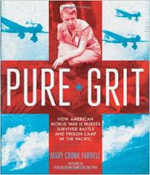 When Mildred Dalton Manning died on March 8, 2013, she was 98 years old. She was also the last of the surviving POW nurses. Nurses were held as Prisoners Of War (POW) the Philippines and nearby territories during WW II. This title brings to light the valuable contributions of 67 POW nurses. The group was finally honored for their contribution by President Ronald Regan in 1983. In 2001, the Commander of POW nurses, Major Maude Campbell Davison was posthumously awarded the Distinguished Service Medal. This impressive volume has 21 chapters, beginning with the motivations for these nurses to join the army or navy and serve in the pacific islands. At that time, they were young and were looking for adventure and romance and a chance to visit some exotic, tropical places when they enlisted in the army. However, the attack on Pearl Harbor, changed not only the events of the history, it also changed the lives of all Americans stationed on foreign soil of Philippines and surrounding regions. The nurses quickly adapted to the conditions and learned to continue their work even as bombs were exploding around them. As Japanese invasion progressed, the hospitals were moved into jungles and underground, and the nurses were rounded up and assigned to a POW camp. For the next three years, they worked under constant starvation, suffered diseases, and worked under the constant supervision of the Japanese soldiers. The author’s website features more information about her books and work.
When Mildred Dalton Manning died on March 8, 2013, she was 98 years old. She was also the last of the surviving POW nurses. Nurses were held as Prisoners Of War (POW) the Philippines and nearby territories during WW II. This title brings to light the valuable contributions of 67 POW nurses. The group was finally honored for their contribution by President Ronald Regan in 1983. In 2001, the Commander of POW nurses, Major Maude Campbell Davison was posthumously awarded the Distinguished Service Medal. This impressive volume has 21 chapters, beginning with the motivations for these nurses to join the army or navy and serve in the pacific islands. At that time, they were young and were looking for adventure and romance and a chance to visit some exotic, tropical places when they enlisted in the army. However, the attack on Pearl Harbor, changed not only the events of the history, it also changed the lives of all Americans stationed on foreign soil of Philippines and surrounding regions. The nurses quickly adapted to the conditions and learned to continue their work even as bombs were exploding around them. As Japanese invasion progressed, the hospitals were moved into jungles and underground, and the nurses were rounded up and assigned to a POW camp. For the next three years, they worked under constant starvation, suffered diseases, and worked under the constant supervision of the Japanese soldiers. The author’s website features more information about her books and work.
—Rani Iyer, Washington State University Pullman
Smith, Lindsay. (2014). Sekret. New York, NY: Roaring Brook Press.
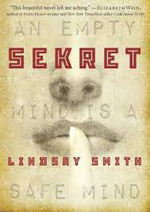 Set in the 1960s when the Cold War between Russian and the United States was at its peak, this story follows Yulia, a girl with psychic power, as she tries to survive and learn the ropes of working in the active espionage scene. After her family has been kidnapped, she is recruited by Russia’s spy agency, the KGB, to protect its space program from American CIA spies. Yulia meets other teens with other psychic powers, some more frightening than hers, to participate in a special mission. The mysterious espionage is intertwined with music and romance, offering some hope to Yulia and letting her have a taste of the world outside of Russia. This book invites readers to be in Yulia’s shoes as she starts falling in love under extremely dangerous conditions and take a look at what it might have been like to live during the Communist Russia. At first, Yuli goes along with the plans of the KGB, however she and her other friends are determined to break free. Readers will be drawn to the story of Yuli and cheer for her freedom.
Set in the 1960s when the Cold War between Russian and the United States was at its peak, this story follows Yulia, a girl with psychic power, as she tries to survive and learn the ropes of working in the active espionage scene. After her family has been kidnapped, she is recruited by Russia’s spy agency, the KGB, to protect its space program from American CIA spies. Yulia meets other teens with other psychic powers, some more frightening than hers, to participate in a special mission. The mysterious espionage is intertwined with music and romance, offering some hope to Yulia and letting her have a taste of the world outside of Russia. This book invites readers to be in Yulia’s shoes as she starts falling in love under extremely dangerous conditions and take a look at what it might have been like to live during the Communist Russia. At first, Yuli goes along with the plans of the KGB, however she and her other friends are determined to break free. Readers will be drawn to the story of Yuli and cheer for her freedom.
—Ying-Hsusan Lee, Washington State University Pullman
These reviews are submitted by members of the International Reading Association's Children's Literature and Reading Special Interest Group (CL/R SIG) and are published weekly on Reading Today Online.